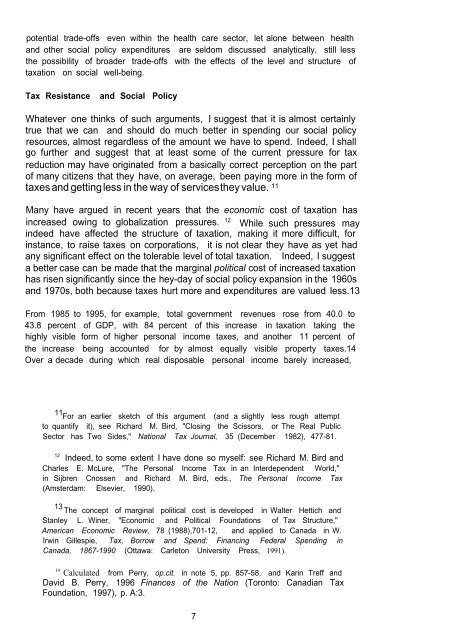Richard Bird - Institute for Public Economics - University of Alberta
Richard Bird - Institute for Public Economics - University of Alberta
Richard Bird - Institute for Public Economics - University of Alberta
You also want an ePaper? Increase the reach of your titles
YUMPU automatically turns print PDFs into web optimized ePapers that Google loves.
potential trade-<strong>of</strong>fs even within the health care sector, let alone between healthand other social policy expenditures are seldom discussed analytically, still lessthe possibility <strong>of</strong> broader trade-<strong>of</strong>fs with the effects <strong>of</strong> the level and structure <strong>of</strong>taxation on social well-being.Tax Resistance and Social PolicyWhatever one thinks <strong>of</strong> such arguments, I suggest that it is almost certainlytrue that we can and should do much better in spending our social policyresources, almost regardless <strong>of</strong> the amount we have to spend. Indeed, I shallgo further and suggest that at least some <strong>of</strong> the current pressure <strong>for</strong> taxreduction may have originated from a basically correct perception on the part<strong>of</strong> many citizens that they have, on average, been paying more in the <strong>for</strong>m <strong>of</strong>taxes and gettingless in the way <strong>of</strong> servicesthey value. 11Many have argued in recent years that the economic cost <strong>of</strong> taxation hasincreased owing to globalization pressures. 12 While such pressures mayindeed have affected the structure <strong>of</strong> taxation, making it more difficult, <strong>for</strong>instance, to raise taxes on corporations, it is not clear they have as yet hadany significant effect on the tolerable level <strong>of</strong> total taxation. Indeed, I suggesta better case can be made that the marginal political cost <strong>of</strong> increased taxationhas risen significantly since the hey-day <strong>of</strong> social policy expansion in the 1960sand 1970s, both because taxes hurt more and expenditures are valued less.13From 1985 to 1995, <strong>for</strong> example, total government revenues rose from 40.0 to43.8 percent <strong>of</strong> GDP, with 84 percent <strong>of</strong> this increase in taxation taking thehighly visible <strong>for</strong>m <strong>of</strong> higher personal income taxes, and another 11 percent <strong>of</strong>the increase being accounted <strong>for</strong> by almost equally visible property taxes.14Over a decade during which real disposable personal income barely increased,11 For an earlier sketch <strong>of</strong> this argument (and a slightly less rough attemptto quantify it), see <strong>Richard</strong> M. <strong>Bird</strong>, "Closing the Scissors, or The Real <strong>Public</strong>Sector has Two Sides," National Tax Journal, 35 (December 1982), 477-81.12Indeed, to some extent I have done so myself: see <strong>Richard</strong> M. <strong>Bird</strong> andCharles E. McLure, "The Personal Income Tax in an Interdependent World,"in Sijbren Cnossen and <strong>Richard</strong> M. <strong>Bird</strong>, eds., The Personal Income Tax(Amsterdam: Elsevier, 1990).13 The concept <strong>of</strong> marginal political cost is developed in Walter Hettich andStanley L. Winer, "Economic and Political Foundations <strong>of</strong> Tax Structure,"American Economic Review, 78 (1988),701-12, and applied to Canada in W.Irwin Gillespie, Tax, Borrow and Spend: Financing Federal Spending inCanada, 1867-1990 (Ottawa: Carleton <strong>University</strong> Press, 1991).14Calculated from Perry, op.cit. in note 5, pp. 857-58, and Karin Treff andDavid B. Perry, 1996 Finances <strong>of</strong> the Nation (Toronto: Canadian TaxFoundation, 1997), p. A:3.7



